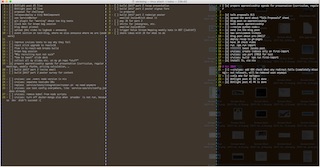


- #Installing vim plugins with pathogen how to#
- #Installing vim plugins with pathogen install#
- #Installing vim plugins with pathogen windows#

The global configuration file is located at /etc/vimrc. Vim's user-specific configuration file is located in the home directory: ~/.vimrc, and Vim files of current user are located inside ~/.vim/. Use the :h command (without any subject) for information about the help system and jumping between subjects. Subjects include commands, configuration options, key bindings, plugins etc. Vim includes a broad help system that can be accessed with the :h subject command.
#Installing vim plugins with pathogen how to#
The unofficial repository herecura also provides a number of Vim/gVim variants: vim-cli, vim-gvim-common, vim-gvim-gtk, vim-gvim-qt, vim-rt and vim-tiny.įor a basic overview on how to use Vim, follow the vim tutorial by running either vimtutor (for the terminal version) or gvimtutor (for the graphical version).The gvim package provides also the CLI version of Vim with the +clipboard feature. The vim package is built without Xorg support specifically the +clipboard feature is missing, so Vim will not be able to operate with the primary and clipboard selection buffers.gvim - which also provides the same as the above vim package with GTK/X support.vim - with Python 2/3, Lua, Ruby and Perl interpreters support but without GTK/X support.6.1.1 Using the built-in package manager.
#Installing vim plugins with pathogen windows#
5.6 Empty space at the bottom of gVim windows.3.6 Traverse line breaks with arrow keys.Provide :Vedit and related commands for editing runtime files.Īllow disabling bundles with g:pathogen_disabled.įix appending "after" directories on Windows.Īdd pathogen#legacyjoin() which escapes spaces for older options like 'path' and 'tags'.įix pathogen#join() to not escape spaces (caused problems on many Windows setups).Īdd pathogen#uniq() to filter out duplicates.Īdd pathogen#helptags() to generate helptags for everything in 'runtimepath'. Provide :Helptags to generate all help tags. Introduce pathogen#surround() to replace pathogen#runtime_prepend_subdirectories().Īllow absolute paths in g:pathogen_disabled.Īdd pathogen#infect() as primary entry point for basic setup. Introduce pathogen#incubate() to replace pathogen#runtime_append_all_bundles(). (Change pathogen#infect('bundle') to pathogen#infect('bundle/*')). Introduce pathogen#interpose() to replace incubate().Īccept multiple arguments to pathogen#infect().ĭeprecate :Vopen commands in favor of vimscript #4394.ĭeprecate pathogen#infect() calls on paths without explicit globs. Use $VIMBLACKLIST to temporarily disable bundles.Īllow disabling rest of vimrc by adding it to blacklist.Įxpand bundle/ as bundle/a and bundle/b.Įxperimental: Support "vimfiles" subdirectory.
#Installing vim plugins with pathogen install#
Install in ~/.vim/autoload (~\vimfiles\autoload on Windows). Use :Helptags to run :helptags on every doc/ directory in your 'runtimepath'.įor more detailed, better formatted documentation, see the README on GitHub: Now any plugins you wish to install can be extracted to a subdirectory under ~/.vim/bundle, and they will be added to the 'runtimepath'. In practical terms, pathogen.vim makes it super easy to install plugins and runtime files in their own private directories. Pathogen.vim : Poor man's package manager.


 0 kommentar(er)
0 kommentar(er)
